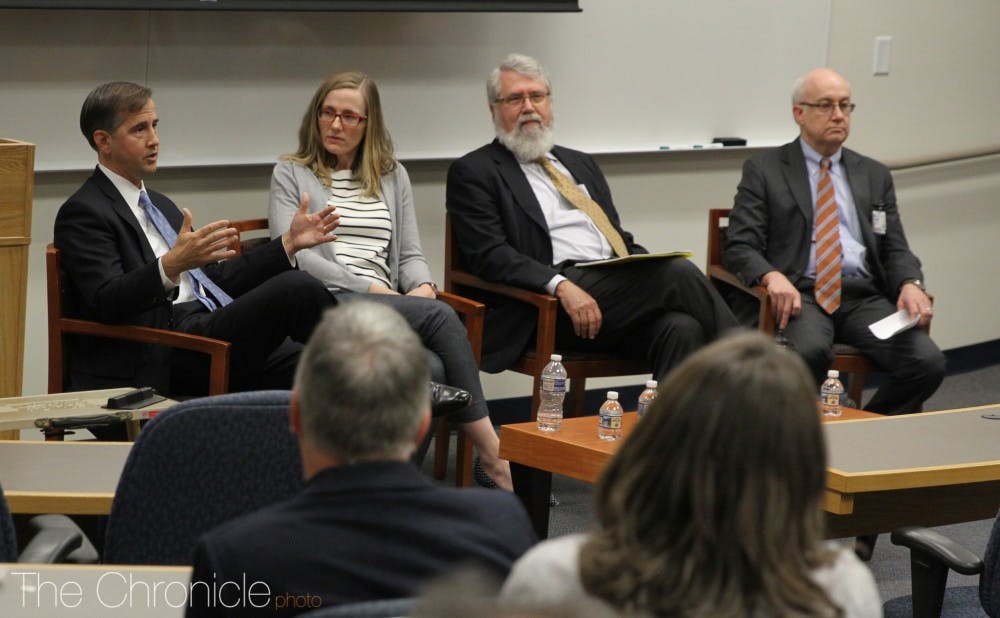At the final Academic Council meeting of the semester markedly more calm than last year’s impassioned debates about Duke Kunshan University, members discussed the University’s finances and approved a new graduate degree for the dance program.
The discussion on budgets and finances in open session—led by Jim Roberts, executive vice provost for finance and administration, Vice President of Finance Tim Walsh and Scott Gibson, executive vice dean for administration in the School of Medicine—was structured by each sharing three points about the University’s finances.
Walsh kicked the conversation off by setting the context—that Duke has a lot of money.
“We felt it would be important to share just one important piece of context—that is that Duke actually has quite a bit of money,” he said. “That’s just a reality. Anyone who would look at it objectively would know that Duke has a lot of money. That said, we have our issues that we have to grapple with.”
Walsh noted that one important caveat to the fact that Duke has a large amount of resources is that there is not much funding that is excess and free to be moved around. Although Duke has approximately $13.6 billion in total net assets and the endowment has cleared over $8 billion, most of that is tied up either by external restrictions or by internal needs.
He also noted that while areas throughout Duke use the University’s funds, there are three primary sources that generate funds—DUMAC, Inc., the professional organization which manages the school’s investments and endowment, Duke University Health System and fundraising campaigns. Walsh noted that most of the money that is put towards new initiatives and innovation is what comes from the fundraising efforts, like the Duke Forward campaign that recently ended.
Roberts pointed out that Duke is constantly experiencing financial tensions that force it to make decisions on tradeoffs for money allocation.
“We’re always wrestling with one problem or another,” he said.
Duke's commitment to a need-blind admissions policy is an example of a program with an unfixed budget which constitutes a large variable in Duke's economic equation. Roberts called managing the budget for the need-blind admissions policy the “single most challenging thing.”
In discussing the financial situation of Duke’s medical programs, Gibson said that the School of Medicine alone generates about $1.3 billion per year in revenue, with about 70 percent of that coming from sponsored research.
He explained that one of the biggest considerations Duke has to face is balancing multi-year investment in its research mission with financial resources that are subject to change.
“We know the research mission costs money,” he said. “But our job is to find the resources to grow the research mission.”
In response to questions from council members, the trio and administrators talked about the current tax reform legislation being deliberated in Congress and whether new buildings like the Wellness Center and the Brodhead Center produce returns on investment.
Michael Schoenfeld, vice president of public affairs and government relations, remarked on the current tax bills by pointing out that there are currently two bills being considered—one in the Senate and one in the House of Representatives—and that the one in the Senate is much more favorable to the University’s interests.
Some of the issues at state for Duke in the tax reform debate, Schoenfeld said, are a potential tax on endowment income for institutions that meet a certain threshold, a tax on graduate student tuition waivers and the elimination of a tax benefit for individuals who donate to universities when the philanthropy results in the opportunity to buy athletic tickets.
“What happens? Well, 24 hours from now we’ll have a much better sense of which of the bills will be around,” he said. “As always with tax legislation, it’s not over until it’s over.”
In response to the question about the cost of new facilities, Executive Vice President Tallman Trask said that in comparison to other schools, Duke’s buildings have been relatively less expensive. He noted that the Brodhead Center cost less than half of what Yale has spent re-doing its dining facilities in recent years, and that it is important to have quality, good-looking buildings.
Walsh noted that historically it has been hard to fundraise for the construction and improvement of dormitories—some of which are at a point “where its almost desperation”—but if DUMAC performs well, the improvements may be possible.
In other business
The Council spent approximately half of the meeting in executive session, in which they heard a general update on Duke Kunshan University and voted on the additional honorary degree proposed for this year’s commencement that they discussed in executive session at the last meeting.
Get The Chronicle straight to your inbox
Sign up for our weekly newsletter. Cancel at any time.
They also approved a new Master of Fine Arts degree program in dance through a voice vote with no members voicing objections or stating abstentions. The new program expects to have its first class of graduate students on campus starting in Fall 2019.
Purnima Shah, associate professor of the practice of dance and director of the Program of Dance, said at the Council’s last meeting that they hope to recruit seven students per year for the two-year terminal degree program.
“We’ve been working very hard on this for over a year, so it’s very exciting," Shah said.
Bre is a senior political science major from South Carolina, and she is the current video editor, special projects editor and recruitment chair for The Chronicle. She is also an associate photography editor and an investigations editor. Previously, she was the editor-in-chief and local and national news department head.
Twitter: @brebradham
Email: breanna.bradham@duke.edu

